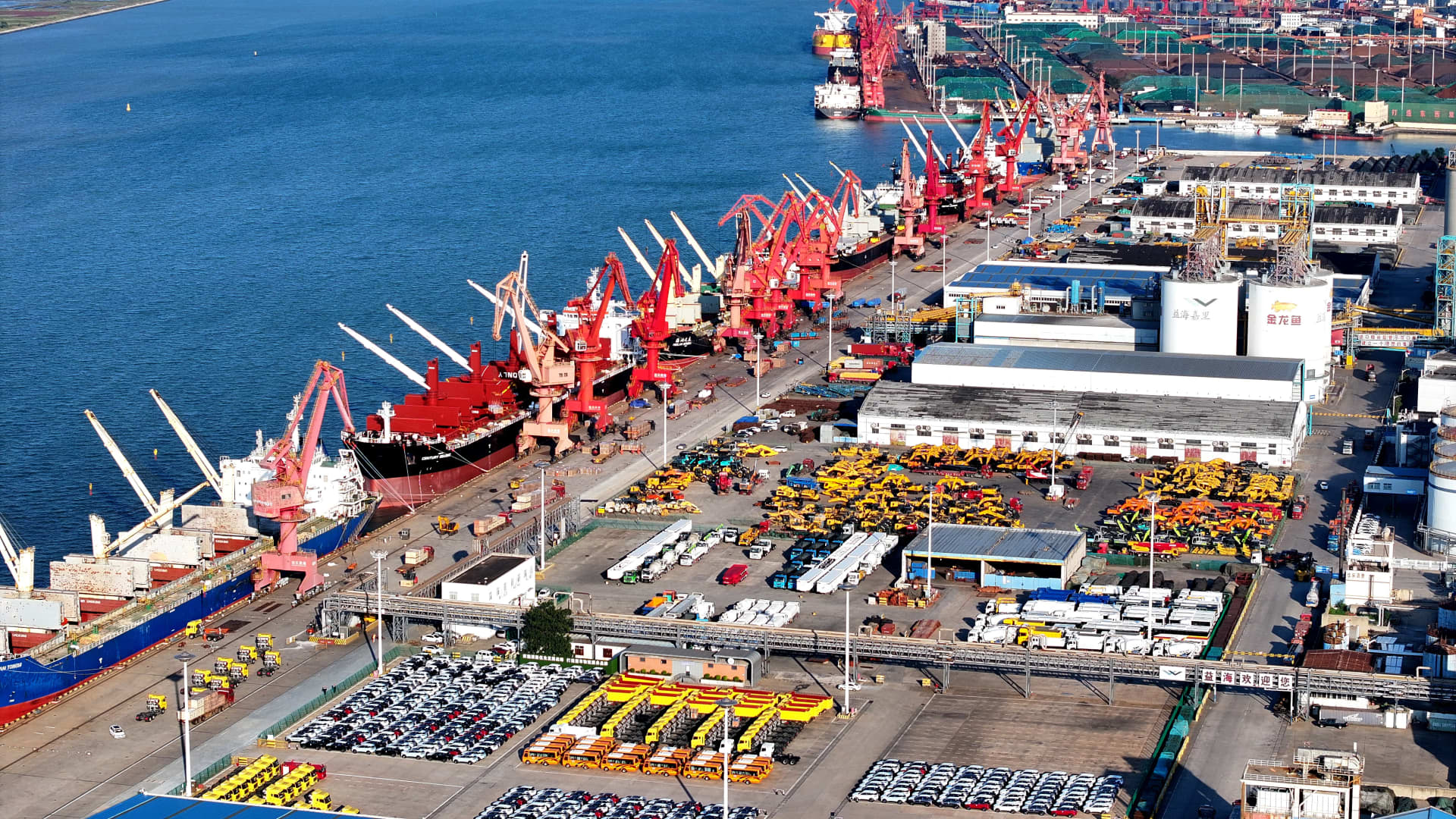A large number of machinery and vehicles are ready for shipment at the dock of the Oriental Port Branch of Lianyungang Port in Lianyungang, China, on September 27, 2024.
Costfoto | Nurphoto | Getty Images
BEIJING — U.S. has raised tariffs on Chinese imports to triple digits. For China’s exporters, it means raising prices for Americans while accelerating plans to diversify operations — and, in some cases, stopping shipments entirely.
U.S. consumers could lose access to certain products in June since some American companies have halted their plans to import textiles from China, said Ryan Zhao, director at Jiangsu Green Willow Textile.
For products that continue to be shipped from China, “it’s impossible to predict” by how much their prices will rise for U.S. consumers, he said Thursday in Chinese, translated by CNBC. “It takes two to four months for products to be shipped from China’s ports and arrive on U.S. supermarket shelves. In the last two months tariffs have climbed from 10% to 125% today.”
The White House has confirmed the U.S. tariff rate on Chinese goods was effectively at 145%. Triple-digit tariffs essentially cut off most trade, a Tax Foundation economist told CNBC’s “The Exchange.”
But U.S.-China trade relationship won’t change overnight, even as American companies that source from China are looking for alternatives.
Tony Post, CEO of U.S.-based running shoe company Topo Athletic, said he is planning to work more with suppliers based in Vietnam in addition to his existing China suppliers.
When the initial two rounds of 10% U.S. tariffs were imposed this year, he said his four China suppliers offered to split the cost with Topo. But now “more than the cost of the product itself has been added in import duties just in the last few months,” he said.
“I’m going to eventually have to raise prices and I don’t know for sure what impact that is going to have on our business,” Post said. Before Trump started with tariffs, Post predicted nearly $100 million in revenue this year — primarily from the U.S.
Economic fallout
Hopes for a U.S.-China deal to resolve trade tensions have faded fast as Beijing has hit back in the last week with tit-for-tat duties on American goods and wide-ranging restrictions on U.S. businesses.
With steep tariffs, China’s shipments to the U.S. will likely plunge by 80% over the next two years, Julian Evans-Pritchard, head of China economics at Capital Economics, said late Thursday.
Goldman Sachs on Thursday cut its China GDP forecast to 4% given the drag from U.S. trade tensions and slower global growth.
While Chinese exports to the U.S. only account for about 3 percentage points of China’s total GDP, there’s still a significant impact on employment, Goldman Sachs analysts said. They estimate around 10 million to 20 million workers in China are involved with U.S.-bound export businesses.
As Beijing tries to address already slowing growth, one of its strategies is to help Chinese exporters sell more at home. China’s Ministry of Commerce said Thursday it recently gathered major business associations to discuss measures to boost sales domestically instead of overseas.
But Chinese consumers have been reluctant to spend, a trend reinforced by yet another drop in consumer price inflation, data released Thursday showed.
“The Chinese domestic market can’t absorb existing supply, much less additional amounts,” said Derek Scissors, senior fellow at the American Enterprise Institute think tank.
He expects Beijing could follow its playbook of making concessions to the U.S., dump products on other countries, subsidize loss-making firms and let other businesses die. Diverting goods to other countries would likely increase local trade barriers for China, while subsidies would exacerbate debt and deflationary pressures at home, Scissors said.
China has made boosting consumption its priority this year and has expanded subsidies for a consumer trade-in program focused on home appliances. Tsinghua University professor Li Daokui told CNBC’s “The China Connection” Thursday that he expected measures to boost consumption would be announced “within 10 days.”
Hard to replace
While the U.S. government has strived over the last several years to encourage manufacturers to build factories in the country, especially in the high-tech sector, businesses and analysts said it won’t be easy to develop those facilities and find experienced workers.
“We cannot obtain comparable equipment from sources in the U.S.,” Ford said in a U.S. tariff exemption request last month for a manufacturing tool used to make its electric-vehicle battery cells. “A U.S. supplier would not have the specific experience with the handling and heating process.”
Tesla and other major corporations have also filed similar requests for exclusion from U.S. tariffs.
A large chunk of goods can mostly be sourced from China alone. For 36% of U.S. imports from China, more than 70% can only come from suppliers based in the Asian country, Goldman Sachs analysts said this week. They said that indicates it will be hard for U.S. importers to find alternatives, despite new tariffs.
On the other hand, just 10% of Chinese imports from the U.S. rely on American suppliers, the report said.
The world’s second-largest economy has also sought to move into higher-end manufacturing. In addition to apparel and footwear, the U.S. relies on China for computers, machinery, home appliances and electronics, Allianz Research said last week.
Diversification
China was the second-largest supplier of U.S. goods in 2024, with imports from China rising by 2.8% to $438.95 billion last year, according to U.S. Census Bureau data. Mexico climbed to first place starting in 2023, while U.S. imports from Vietnam — which has benefitted from re-routing of Chinese goods — more than doubled in 2024 from 2019, the data showed.
Several large Chinese textile companies have been moving some production to Southeast Asia, Green Willow Textile’s Zhao said.
As for his own company, “this year we are developing customers in Southeast Asia, Latin America, the Middle East and Europe in order to reduce our reliance on the U.S. market,” Zhao said, noting the company could not bear the cost of the additional tariffs given its already low net profit of 5% last year.
China’s trade with Southeast Asia has grown rapidly since 2019, making the region the country’s largest trading partner, followed by the European Union and then the U.S. in 2024, according to Chinese customs data.
Chinese President Xi Jinping is set to visit Vietnam on Monday and Tuesday, followed by a trip to Malaysia and Cambodia later in the week, state media said Friday, citing China’s foreign ministry.
“I suspect that we will have a bit of a whack-a-mole situation where there will be new rules coming to crack down on Chinese content in products that ultimately end up in the United States,” Deborah Elms, head of the Hinrich Foundation, said on CNBC’s “The China Connection” Thursday.
Trump on Wednesday paused plans for a sharp hike on tariffs for most countries, including in Southeast Asia, but not for China.
That pause has offered a brief relief to people like Steve Greenspon, CEO of Illinois-based houseware company Honey-Can-Do International, whose company has moved more production from China to Vietnam since Trump’s first term.
“The pause allows us to continue with business as usual outside of China, but we cannot make any long term plans,” said Greenspon. “It’s hard to know how to pivot as we don’t know what will happen in 90 days.”
The economic realities could push the U.S. and China toward a deal, some analysts predict.
Gary Dvorchak, managing director at Blueshirt Group, pointed out Thursday that the latest tariffs have only been announced in the last several days and he expects ratcheting up of duties is likely posturing ahead of a deal — potentially as soon in the next few days.
Despite aggressive rhetoric, he thinks both countries have much to lose if the tariffs are made permanent. To have the U.S. cut off from Chinese goods would plunge China into a deeper depression, he said.

 Blog Post7 days ago
Blog Post7 days ago
 Economics1 week ago
Economics1 week ago
 Personal Finance1 week ago
Personal Finance1 week ago
 Economics1 week ago
Economics1 week ago
 Personal Finance1 week ago
Personal Finance1 week ago
 Accounting1 week ago
Accounting1 week ago
 Finance1 week ago
Finance1 week ago
 Finance1 week ago
Finance1 week ago











